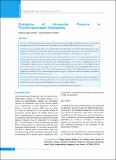Please use this identifier to cite or link to this item:
https://hdl.handle.net/20.500.14356/1219Full metadata record
| DC Field | Value | Language |
|---|---|---|
| dc.contributor.author | Adhikari, Pragati Gautam | - |
| dc.contributor.author | Shrestha, Gulshan Bahadur | - |
| dc.date.accessioned | 2023-05-03T06:26:35Z | - |
| dc.date.available | 2023-05-03T06:26:35Z | - |
| dc.date.issued | 2021 | - |
| dc.identifier.citation | Gautam AdhikariP., & ShresthaG. B. (2022). Evaluation of Intraocular Pressure in Thyroid-associated Orbitopathy. Journal of Nepal Health Research Council, 19(04), 824-829. https://doi.org/10.33314/jnhrc.v19i04.3963 | en_US |
| dc.identifier.issn | Print ISSN: 1727-5482; Online ISSN: 1999-6217 | - |
| dc.identifier.uri | http://103.69.126.140:8080/handle/20.500.14356/1219 | - |
| dc.description | Original Article | en_US |
| dc.description.abstract | Abstract Background: Elevated intraocular pressure in thyroid associated orbitopathy may lead to development of secondary glaucoma in them. This study evaluated IOP in primary gaze correlation with clinical activity score in them. Methods: A cross-sectional study was conducted from November 2020 to October 2021.Information on age, gender, thyroid function test, intraocular pressure, cup-disc ratio and clinical activity score were recorded. Purposive sampling was done. Statistical analysis was done using Statistical Package for Social Sciences version 21. Results: Total of 74 thyroid dysfunction patients was included in the study. There were14.86% patients with raised intraocular pressure. The mean intraocular pressure in hyperthyroidism was 15.4 ± 1.92 mm Hg and 15.48 ± 2.11mm Hg on right and left eyes respectively and in hypothyroidism, it was 15.08 ± 2.7mmHg and 15.12 ± 3.02 mmHg on right and left eyes respectively. The mean clinical activity score was 1.06 ± 1.23 mmHg. The mean intraocular pressure in eyes in active stage (n=9) was 16.3 ± 3.4 mm Hg, which was not significantly different from the mean intraocular pressure of 15 ± 2.4 mm Hg in inactive eyes (64), p= 0.1. Clinical activity score showed a significant correlation (p=0.03) with intraocular pressure in right eyes whereas it showed no significant correlation with intraocular pressure in left eyes (p=0.37). Conclusions: In this study elevated intraocular pressure occurred in about 1 in 7 thyroid associated orbitopathy. It also had positive correlation with clinically activity score in right eyes. Regular intraocular pressure measurement should be done in thyroid associated orbitopathy to prevent intraocular morbidity. Keywords: Clinical activity score; intraocular pressure; orbitopathy; thyroid dysfunction. | en_US |
| dc.language.iso | en | en_US |
| dc.publisher | Nepal Health Research Council | en_US |
| dc.relation.ispartofseries | Oct-Dec, 2021;3963 | - |
| dc.subject | Clinical activity score | en_US |
| dc.subject | intraocular pressure | en_US |
| dc.subject | orbitopathy | en_US |
| dc.subject | thyroid dysfunction | en_US |
| dc.title | Evaluation of Intraocular Pressure in Thyroid-associated Orbitopathy | en_US |
| dc.type | Journal Article | en_US |
| local.journal.category | Original Article | - |
| Appears in Collections: | Vol. 19 No. 04 (2021): Vol 19 No 4 Issue 53 Oct-Dec 2021 | |
Files in This Item:
| File | Description | Size | Format | |
|---|---|---|---|---|
| 3963-Manuscript-26797-1-10-20220313.pdf | Fulltext Download | 226.57 kB | Adobe PDF |  View/Open |
Items in DSpace are protected by copyright, with all rights reserved, unless otherwise indicated.
